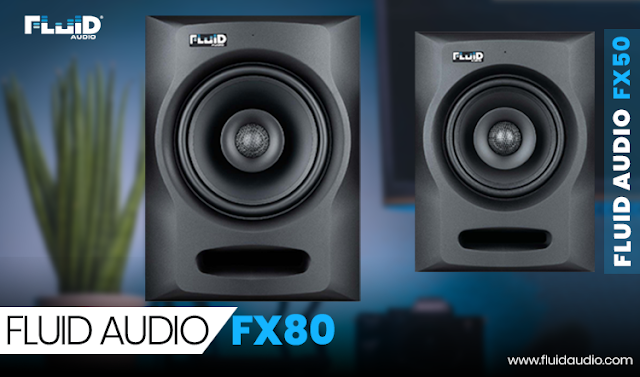Fluid Audio FX50 and Fluid Audio FX80
Audio monitor loudspeakers are the backbone of any recording studio. Regardless of the music or audio project, you are working on, your studio monitors can make or break your success. They decide how clearly you hear your mix, and whether they present you with opportunities to make your music the best it can sound. That is why your monitors should receive the most care and level of research before buying them.
It is natural to feel the temptation to spend a ton of money on studio monitors, thinking you need “only the best”. However, an expensive price tag is no assurance of high-quality studio monitors. The trick is to get the maximum bang for your buck. The FX series by Fluid Audio offers some of the best sounding monitors at a very reasonable price. Here is a closer look at the Fluid Audio FX50 and FX80.
We will start off with some of the features shared by both these models and then let you decide which is the right one for you.
Coaxial Driver and its benefits
Space is a crucial factor when it comes to deciding which monitor is right for your studio. Larger speaker drivers and cabinets often offer more power handling and better clarity (if a 3-way design) but usually come with a hefty price tag. They also take up a lot of space which can be a problem in a home studio. Smaller monitor speakers, on the other hand, may not offer the same level of audio fidelity even if they are better when it comes to the amount of space they take up. The coaxial driver systems used by Fluid Audio marry the best of both worlds.
The tweeter is mounted in the center of the woofer and this concentric mounting allows the monitor to be much shorter than a traditional monitor with similar specs. It also improves the sound reproduction as it is a “point source” device (all the frequencies originating from the same point in space) as well as having the same off-axis response both horizontally and vertically.
Class D amplification and Standalone DSP
Another very important and often overlooked aspect of a studio monitor is power. Class D amplification is much more efficient than the Class AB amps found in a lot of monitors. Not only does this make the speaker cabinet much lighter weight, but it also performs much cooler and will not get hot and overheat. The FX series amps also come with built-in DSP (digital processing), which is used not only to control the zero-tolerance crossover filters, but also the limiting and protective circuits. The DSP also controls the DIP switches which are discussed below.
Boundary compensation
While the features discussed so far are impressive, this is the one that makes the FX50 and FX80 really stand out. Even the best studio monitors can be negatively impacted by the space in which they are operating. Even acoustically treated environments can sometimes not be enough.
To account for this, you can choose from the available DIP switches on the rear panels of the FX50 and FX80. These allow you to compensate the EQ (add or remove energy) according to the space it is placed in. Using the DIP switches, you can tailor the sound to your exact preference and/or room. It might seem a bit complicated initially but the user guide explains it very well and you will get the hang of it in no time.
Fluid Audio FX50 or FX80? The choice is yours
The FX50 and FX80 from Fluid Audio are excellent monitors and they both offer superb sound quality and imaging. Thanks to the coaxial design, all the sound emanates from the same point in space. This allows for a consistent listening window regardless of your seating position. (This is what is known as a “large sweet spot”). The frequency response is flat. The bass response is tight and just right without being overpowering, while the mids and the highs are articulate and clear. You can easily zoom in to any part of your mix and make the necessary adjustments required.
As for the specific choice between these two models, it all comes down to your budget, use case, and the space you have. The Fluid Audio FX50 is a smaller cabinet with a 5" woofer driver and a 1" tweeter. The Fluid Audio FX80 has an 8" woofer with a 1.2" tweeter. The FX50 has a power output of 90W while the FX80 can put out 110W. The FX80 can also go as low as 35Hz as opposed to the FX50's 49Hz, although both reach a maximum frequency of 22KHz.
The FX80 is obviously larger, heavier, and louder. It also costs $250. The FX50 is half the weight of the FX80 and is $100 cheaper. They have been voiced to be very similar in audio “signature” and your choice of model will come down to what you specifically need in performance. The FX80’s lower bass response makes it handier in bass-heavy applications while the FX50 is a great all-purpose monitor that many actually use in Dolby Atmos setups due to its great sound and placement versatility.
Regardless of which model you choose, you will not be disappointed. These monitors offer a level of audio fidelity not seen in this price range. Hearing reverb trails and multilayered delays is a breeze with these monitors. So, if you are looking to take your studio to the next level then look no further than the Fluid Audio FX50 and FX80.



Comments
Post a Comment